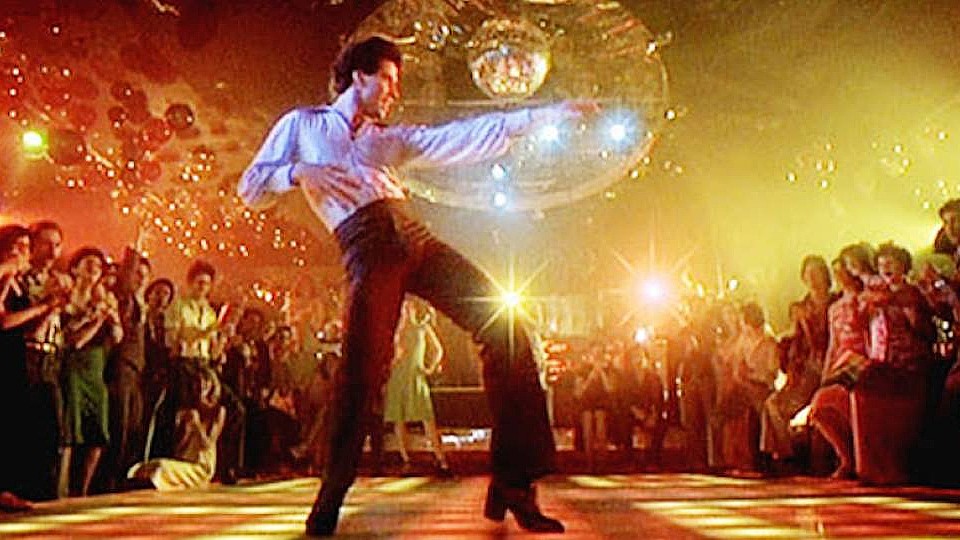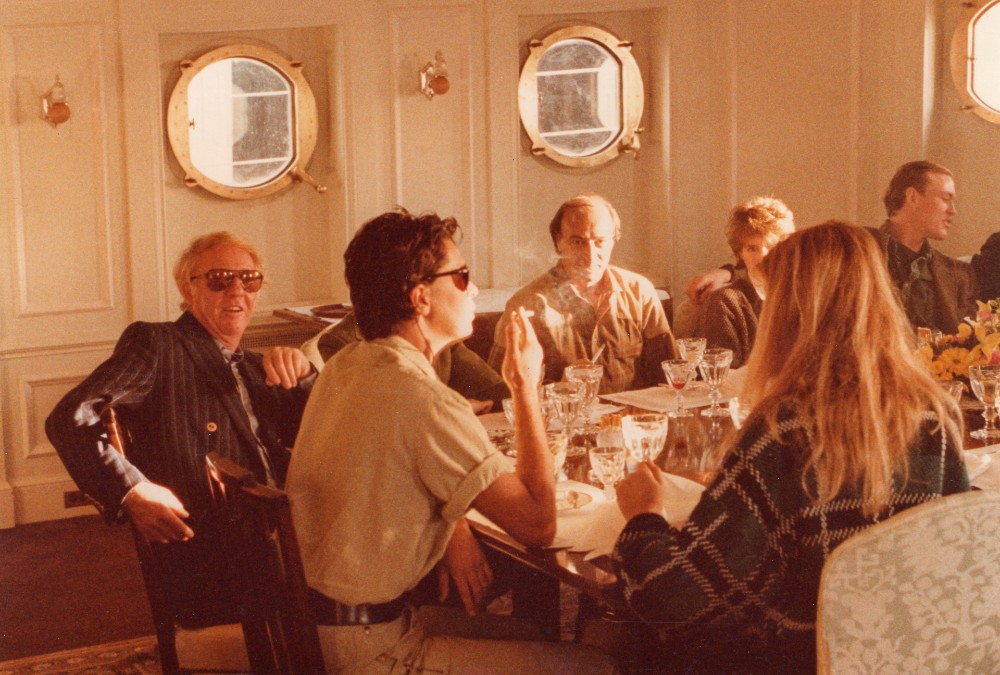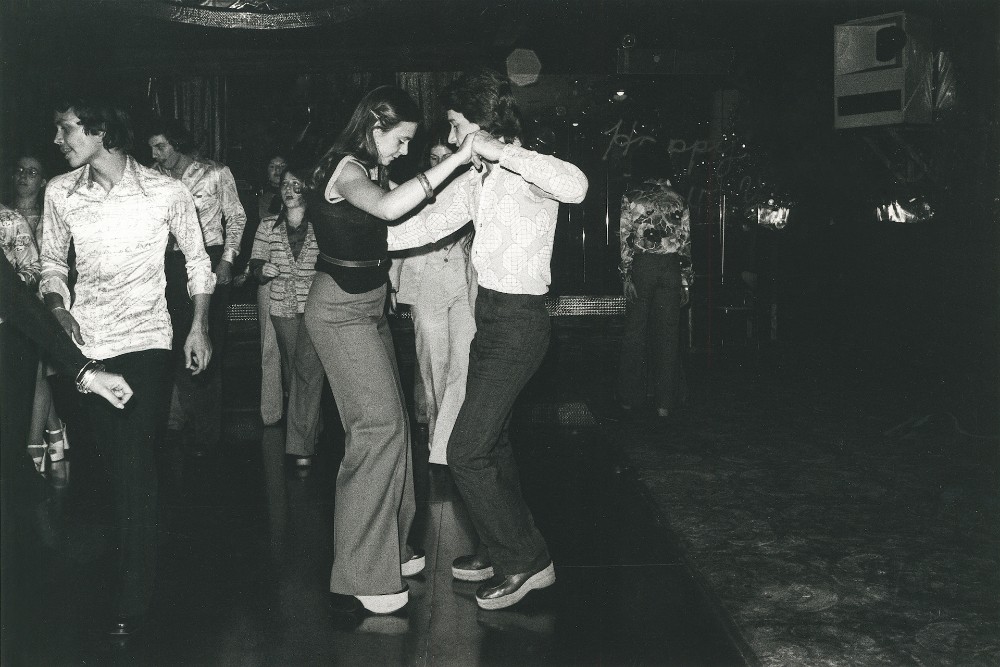
If there’s one thing to say about the entertainment biz in the ‘70s, it’s that by the decade’s second half, the peace and love of the ‘60s has devolved into a level of excess that flourished even further in the ‘80s. In the music side of the business, it was more the evolution of disco that led to clubs like New York’s Studio 54 and others being the go-to places to be seen. That disco scene was already flourishing when producer and band manager Robert Stigwood came up with the idea of putting fledgling teen idol John Travolta into a project based on the underground dance scene growing in Bay Ridge, Brooklyn.
Stigwood’s second stroke of genius was getting the band he managed, the Bee Gees, to write a score for that 1977 movie, Saturday Night Fever. While the movie did huge business at the box office and turned Travolta into a bonafide star, that soundtrack sold millions and millions of records worldwide, paving the way for how movies and music would be used together for the years to come.
Documentary filmmaker John Maggio saw something in the story of Stigwood and Saturday Night Fever that led to him making the doc, Mr. Saturday Night, as part of HBO’s “Music Box” series. It covers Stigwood’s life and career but mostly focuses on the time around Saturday Night Fever, and how it helped turn Stigwood into a billionaire with the Midas touch for the rest of the decade.
Below the Line spoke with Maggio over Zoom about this fascinating tycoon and the legacy he left behind with Saturday Night Fever, and how that story is told in Mr. Saturday Night.
Below the Line: I was maybe 12 or 13 when Saturday Night Fever came out, so I wasn’t able to see it in theaters, but I knew the soundtrack well… and the fashion.
John Maggio: My older brothers were big disco guys. They’re like 58 and 60, my two oldest brothers, and I can still see them feathering their hair back and putting on their polyester, and going to the clubs. That was a big deal. I remember thinking about the music back then. One of the reasons I got into this is Bill Simmons of Ringer Films, he really liked a film I made called Panic. We were talking about what I wanted to do next, and we were talking about music docs and things. I just started thinking this before I knew there was a big Bee Gees doc coming up. I said that I’ve always really loved the Bee Gees. I’m also a musician. I love great songwriters, and melodies and that kind of stuff. And as I dug into learning about the Bee Gees, I discovered Robert Stigwood. I had never heard of the guy before, and then you start to peel the onion like… “Oh, he also managed The Who, one of my favorite bands, and Cream and Clapton and the Bee Gees. He knew [Brian] Epstein and was about to manage the Beatles. He made Evita and Jesus Christ Superstar and Tommy!” It just starts this cavalcade of material and creative output from like the late 60s until 1980. I was like, “I’d like to introduce this guy to the world. I don’t think a lot of people know much about him.”

And then, on top of that, I started to realize that the actual story of the making of Saturday Night Fever… I had known a little bit about it – I’d done a series on Italian Americans many years ago, and knew a lot of the guys in Bay Ridge that had gone to Club 2001. That was like one of their greatest moments as teenagers, when they came to film that movie. I understood the story behind the refuting actual sort of authorship, the journalism behind the story. I was a little aware of the story and as I picked it apart, I started to realize there was a great yarn to be told here. Bill and I talked a lot about wanting to do a music film that was a little left of center, not like a root to ball biography, but just capture a moment. It seemed to me, Stigwood was at the height of his powers in the mid-70s, where he could not NOT make a hit. He just had the touch. So all of those forces came together, and I thought, “I want to do this.” And I only wanted to talk to people who were there for it. I didn’t want to talk to historians. That was also the reason I also made a creative decision not to do shot interviews, but just stitch together with archival audio interviews and various things, because I wanted it to almost be sort of encased in amber and be very immersive, and experiencing people as they were when they were doing.
BTL: How did you go about finding those interviews? Some of them might have been on TV and there’s the museum that has an archive, but since it’s all from the ’70s, so 50 years plus and maybe harder to find.
Maggio: You dig around, you hire great archivists. And where there were holes, we approached people and did some phone interviews. For me, it was just trying to create this pastiche of voices and texture. So some of those interviews are from today that I just did over Zoom or over the phone. One of the really key people was Kevin McCormick, who is a big Hollywood producer now but was like a 21-year-old Head of Development. He had no idea what he was doing back in the ’70s, working for RSO, and he was really helpful to help me stitch together this story. I called some of the music engineers and some of the people that would eventually appear in the Bee Gees doc. I just was recording everything and then digging up all the extended archive that we could. It’s a process, it took a while. These films are always difficult to make when you just stitch them together like that, but I think it’s rewarding in the end. I think it feels very, as I say, immersive.
BTL: Did Robert Stigwood have any siblings or any kind of family at all who you could talk to?
Maggio: No, I mean, obviously, he had his parents. I think he had a sister, he had like a nephew. He had some smattering of family. I think there’s still a nephew that’s around. But the estate is run by this guy Patrick Biwalski, who splits his time between London and the South of France. He was a longtime assistant to Stigwood. He’s in the film. You see him on the yacht in various places. He’s the chauffeur who picked up Stigwood to come to Capri. He kind of runs the estate, so that’s who we approached originally to sort of get the rights to tell the story. We want to make sure the estate was involved. The question that still remains, for me is where that fortune is. I mean, he made probably close to half a billion dollars in 1977 between Grease and Saturday Night Fever and the soundtrack. He made a lotta, lotta money. He spends a lot of money, too, so I don’t know where all that wealth has spread out to.
BTL: Half a billion dollars in the ’70s is the equivalent of 5 billion dollars today or more even.
Maggio: It’s incredible and mind-boggling to think about. The numbers are really, really incredible.

BTL: I still haven’t seen Frank Marshall’s Bee Gees doc you mentioned. I’ve heard great things about it, and I’ve heard him talking about it on podcasts, but never got around to watching it. Did you actually watch it while you were still working on your doc or before you finished it?
Maggio: I was very close to the end of production when that came out and watched it. My film was never going to be focused completely on… the Bee Gees are a big part of the story, but as you see in the film, they sort of come in and out. But that was always a creative choice, too. I wanted the film — it’s [called] Mr. Saturday Night — to be about Stigwood and the making of the film, because there’s plenty of story to tell around that. When I watched the Bee Gees doc. Yeah, I like it. It’s a traditional root to ball sort of doc about their life. It’s good. It’s good, because they’re great. Sadly, Barry [Gibb] is the only one still alive, and they use old archival interviews and stuff. I mean, if you like the Bee Gees, it’s definitely a solid biography of them. And obviously, Saturday Night Fever remade them. Shortly before, I guess in ’76, they had done “Jive Talkin’.” What’s interesting, now that I think about it, is just as feel that at the same moment that Stigwood had that golden touch, Barry Gibb did as well, from a songwriting perspective. He was also incapable of not writing just a hit song. He just had it, he really had it in his bones. So then put those two forces together, it’s kind of an incredible, once-in-a-lifetime moment where the manager and an artist are really just in sync with each other, creatively. And it was a huge success. The Bee Gees are a big part of it, and you’ll learn more about the Bee Gees watching that Bee Gees doc, but certainly, we get in pretty deep on that moment to them and the inevitable backlash to them, which I think really hurt them. They took it very personally.
BTL: I’m just fascinated by the rise of John Travolta during that period. I mean, he had such confidence when he was on screen, and I loved seeing the behind-the-scenes footage of him being mobbed by fans in Bay Ridge. How did you find that footage?
Maggio: There were a lot of EPKs made of the making of the film, so I had that footage, Paramount had stuff, short ends and things. You just really root around and try to find all those little moments. Some of the stuff I love most is when he’s learning some of those moves from Deney Terrio. Deney Terrio got very popular — I was probably like 10, maybe a little younger when Dance Fever was on. Deney Terrio loomed large, just his ability to move and all that stuff. And of course, Soul Train. I just love watching Soul Train. Again, getting Deney Terrio to teach him those moves and stuff, I love that part of the film. Deney Terrio and how he came to be part of the film is also funny.
All these guys were just kind of gamblers, taking risks that hopefully something would stick. It is cool, the footage around the making of it, but then again, the vision that Stigwood had to see this TV star, this teen idol, could be a matinee idol. It doesn’t always translate. It translates more today, because there’s so much simpatico stuff between TV and cinema now, but back then, it was not really that common for a TV star to make the leap to the big screen. Somehow, Stigwood saw that [Travolta] was going to be a star. Again, it’s that weird sense of smell that Stigwood had that he set something big here with Travolta. Travolta, he really is the linchpin to this whole operation. Stigwood had Travolta. He didn’t even have the movies yet lined up. He had Grease in his back pocket, but then when Kevin McCormick went out and found the article in New York Magazine, “The Tribal Rites of the New Saturday Night.” He saw that could be for John, and when they brought it to John, he said, “Yes.” So, thank God! You hear all these stories about the roles people turned down. It made his career, that one movie. I mean, it was astounding.

BTL: I do want to talk about your editor Seth Bomse, who you worked with on a previous movie. How do you work with him on this? Were you feeding him footage as you got it or did you put it all together and sit down and digitize it and then figure out the story? How did you get him involved?
Maggio: Seth and I, we’ve done a number of films together, and we have a real shorthand. I do a lot of political films, and normally, that’s a very much controlled thing in my head. There are themes I’m trying to tease out, the big ideas that we’re coming into, and I’m shooting interview, so I’m very immersed in the material. This was a different beast. This was “Let’s collect all this material. See what we got.” I had a general outline for the story, as I saw it, as I understood it, and then Seth works his magic. Seth and I, we also worked with a great music supervisor, who was feeding us great tracks. We had a lot of resources from HBO and Ringer to spend money on those tracks, so we were able to just try to find those scenes where we wanted to settle in. Seth is great at finding the nuance of all of this stuff, and has a great field and a great rhythm that you need in an editor. He would rough things in, we’d look at it, I’d see if the themes are emerging, and what was grabbing me emotionally? What was building on the story? And then he would just go to town. He’s also a producer on this film, because I felt that it’s an editor’s film in many ways, to stitch all this archive together. It’s really a dance. As I say, we have this kind of shorthand. We both have similar tastes, and if I had to work with an editor that I hadn’t worked with before, it would have been a lot harder. Let me put it that way.
Seth was able to kind of take the archives and build on it, and we had good archivists that we can turn to. Often times, too, we were both like, “Boy, I wish there was this. Isn’t there something of Stigwood in London?” And then suddenly this BBC thing picks up and there’s Stigwood driving a go-kart around his estate. Suddenly, it feels like a Wes Anderson film. So you have those little happy moments and those little great discoveries that you weren’t planning on that then suddenly, you develop a scene. You hear Stigwood start talking about how he’s a gambler, and it’s his voice, so suddenly that emerges. But that scene didn’t exist until we found that piece of archive, so it is a trick. It takes a lot of patience.
BTL: You also worked with Composer Gary Lionelli again, and that must have been tough for a music doc, because you have so much Bee Gees music, and so much music in general, so what was the direction you gave him?
Maggio: Gary’s done 10 or 11 of my films. I mean, he’s always been with me, partly because we also have a shorthand in creative endeavors like this. When I started making films, I always wanted to have a team I turned to that sees the world the way I do or sees it a little differently. A lot of times, I’ll have a whole idea for a film and Seth will look and say, “Oh, actually, the film’s over here, the more interesting stories are there.” A film eventually tells you what it is. I think that the way I work with Gary is often we will temp with things and see what’s working. So that gives him a kind of general roadmap of what we wanted in between the needle drop tracks we have of all the great disco music. Gary, too, will take that as a template, that temp music, then he always builds on it or changes it or see things I didn’t see, kind of brings a sort of nuance that I just love. That’s one of the reasons I always work with him. So again, it’s an iterative process. It’s like generally, Gary will use much of the music I’ve already used in the past with Gary, we’ll sort of temp with that or track some other films, so it’s in his wheelhouse, to begin with. So that when I give him the rough cut, and he starts kind of writing o picture, it’s in his sort of headspace. But again, it’s just that back and forth, iteration after iteration, until we hit just the right emotional sort of cue for me. Ultimately, it’s me that I have to decide what’s working and what’s not working, but two great collaborators, like Seth and Gary, are just an embarrassment of riches.
BTL: You obviously had a very focused movie on Stigwood and Saturday Night Fever, but there’s so many different directions you could have gone from his musicals to his disastrous Sgt. Pepper’s movie. Would you ever consider making a second Stigwood doc may be covering some of that stuff?
Maggio: I just did a film on the life of Gordon Parks but just really focused on his photography. He’s a filmmaker and a writer and a poet and a songwriter. There’s so many different things, but I just think that I like to tell these discreet sorts of moments in time of a character. You learn a lot about the character in those kinds of pockets of moments, but yes, of course, I mean, Stigwood and Broadway. I talked to Tim Rice a lot about his work on Jesus Christ Superstar, and I’m sure there’s a million stories Andrew Lloyd Webber could tell about Stigwood. He was such a giant in the industry. Or talk to Clapton… he was with Clapton through Cream and then continued to manage Clapton throughout the years. Each one is probably a great story for sure. As we said earlier, his time in London could probably be a film. I think somebody is thinking about doing a scripted version of that period in London, Stigwood’s role. So yeah, there’s more to come. Often, my films, they are catalysts for people to go and dig maybe a little bit deeper. In the end, I’m really a storyteller. If there’s more to learn, I think my films have a certain amount of depth, but if you want to learn more, they’re a great entryway into wanting to dig further. When I work with authors on books or reporters… you can spend a lot of time on a long magazine article, a newspaper article, or in a book, go down dark alleyways that you can’t do in a film. I paint in broad strokes very often, to capture people emotionally or otherwise and get them thinking. There’s probably books to be written about Stigwood. There’s a lot that can be done, for sure, and maybe people will.
Mr. Saturday Night is now streaming on HBO Max through its “Music Box” series. All photos courtesy HBO, except where noted.





